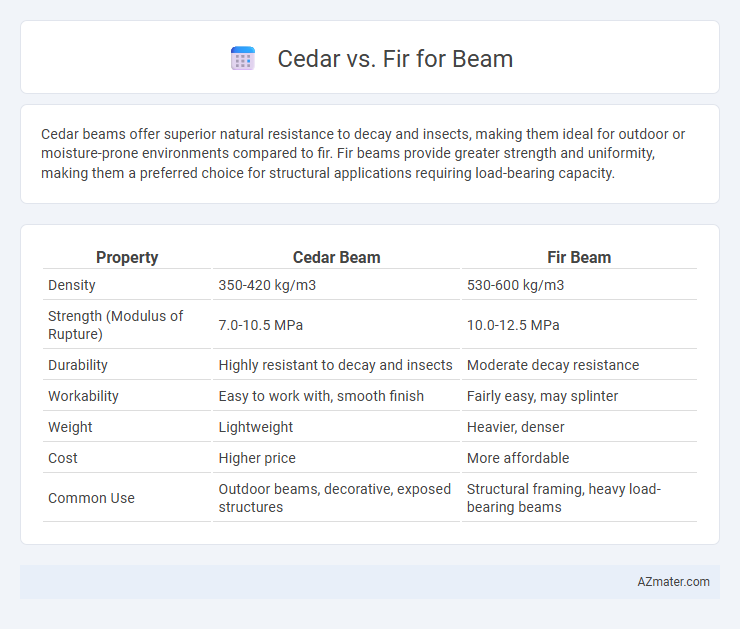Cedar beams offer superior natural resistance to decay and insects, making them ideal for outdoor or moisture-prone environments compared to fir. Fir beams provide greater strength and uniformity, making them a preferred choice for structural applications requiring load-bearing capacity.
Table of Comparison
| Property | Cedar Beam | Fir Beam |
|---|---|---|
| Density | 350-420 kg/m3 | 530-600 kg/m3 |
| Strength (Modulus of Rupture) | 7.0-10.5 MPa | 10.0-12.5 MPa |
| Durability | Highly resistant to decay and insects | Moderate decay resistance |
| Workability | Easy to work with, smooth finish | Fairly easy, may splinter |
| Weight | Lightweight | Heavier, denser |
| Cost | Higher price | More affordable |
| Common Use | Outdoor beams, decorative, exposed structures | Structural framing, heavy load-bearing beams |
Introduction: Cedar vs Fir Beams
Cedar and fir beams differ significantly in durability and strength, with cedar known for its natural resistance to decay and insects, making it ideal for outdoor or exposed applications. Fir beams offer superior structural strength and stability, often favored in construction projects requiring heavy load-bearing capacity. Choosing between cedar and fir for beams depends on the specific needs of the project, balancing aesthetic appeal, structural requirements, and environmental exposure.
Wood Characteristics: Cedar and Fir
Cedar beams are prized for their natural resistance to decay and insect damage, offering exceptional durability and a warm, rich color that deepens over time. Fir beams boast superior strength and stiffness, providing excellent structural support with a straight grain that minimizes warping and splitting. Both woods feature dimensional stability, but cedar's lighter weight and aromatic properties make it a popular choice for aesthetic and functional wood beams.
Strength and Structural Integrity
Fir beams offer superior strength and structural integrity compared to cedar, with higher load-bearing capacity and greater resistance to warping under heavy stress. Cedar, while naturally resistant to decay and insects, is softer and less dense, making it less ideal for critical structural applications where maximum durability is required. For construction projects prioritizing long-term stability and safety, fir remains the preferred choice for beams due to its consistently higher modulus of elasticity and compressive strength.
Durability and Longevity
Cedar beams offer superior natural resistance to decay, insects, and moisture, making them highly durable for long-term structural use. Fir beams, while strong and dense, are more susceptible to rot and insect damage without proper treatment, reducing their longevity. The inherent preservative oils in cedar contribute to its extended lifespan compared to fir, which often requires chemical protection to achieve similar durability.
Weather and Pest Resistance
Cedar beams offer superior natural resistance to weathering and pests due to their high oil content, which repels moisture and insects effectively, making them ideal for outdoor and exposed structural use. Fir beams, while strong and stable, are more susceptible to moisture absorption and insect damage, requiring additional treatments to enhance durability in harsh weather conditions. Choosing cedar over fir ensures longer-lasting structural integrity in environments with high humidity and pest activity.
Workability and Ease of Installation
Cedar beams are known for their lightweight and straight grain, which enhances workability and simplifies cutting, drilling, and fastening during installation. Fir beams, while slightly heavier, offer uniform strength and consistent density, making them easier to machine and providing stable structural support. Both woods install efficiently, but cedar's natural resistance to splitting and warping often results in a smoother, faster installation process.
Aesthetic Appeal and Grain Pattern
Cedar beams exhibit a warm, reddish-brown hue with distinct knots and a straight, uniform grain that enhances rustic and natural aesthetics. Fir beams offer a lighter, more subtle color palette with a fine, even grain that creates a sleek and contemporary look. The choice between cedar and fir for beams heavily depends on the desired visual impact, with cedar providing a richer, more textured appearance and fir delivering a clean, refined finish.
Cost Comparison: Cedar vs Fir
Cedar beams generally cost more than fir beams due to cedar's natural resistance to decay and insect damage, increasing its value for long-term durability. Fir beams, often sourced from Douglas fir, provide a more budget-friendly option while maintaining strong structural integrity, making them cost-effective for large projects. Price variations depend on grade, treatment, and regional availability, with cedar typically commanding a premium in most markets.
Ideal Applications for Each Wood Type
Cedar beams excel in outdoor applications such as pergolas, decks, and porch supports due to their natural resistance to decay, insects, and moisture. Fir beams are ideal for indoor structural uses like ceiling joists, floor beams, and framing because of their strength, straight grain, and affordability. Selecting cedar ensures longevity in exposed environments, while fir provides robust support in dry, controlled conditions.
Conclusion: Choosing the Right Beam Wood
Cedar offers natural resistance to decay and insects, making it ideal for outdoor or moist environments, while fir boasts superior strength and dimensional stability suited for structural supports. Fir beams provide better load-bearing capacity, making them preferred in heavy construction projects, whereas cedar beams emphasize longevity and aesthetic appeal. Selecting the right beam wood depends on prioritizing durability or strength for specific building requirements.

Infographic: Cedar vs Fir for Beam
 azmater.com
azmater.com